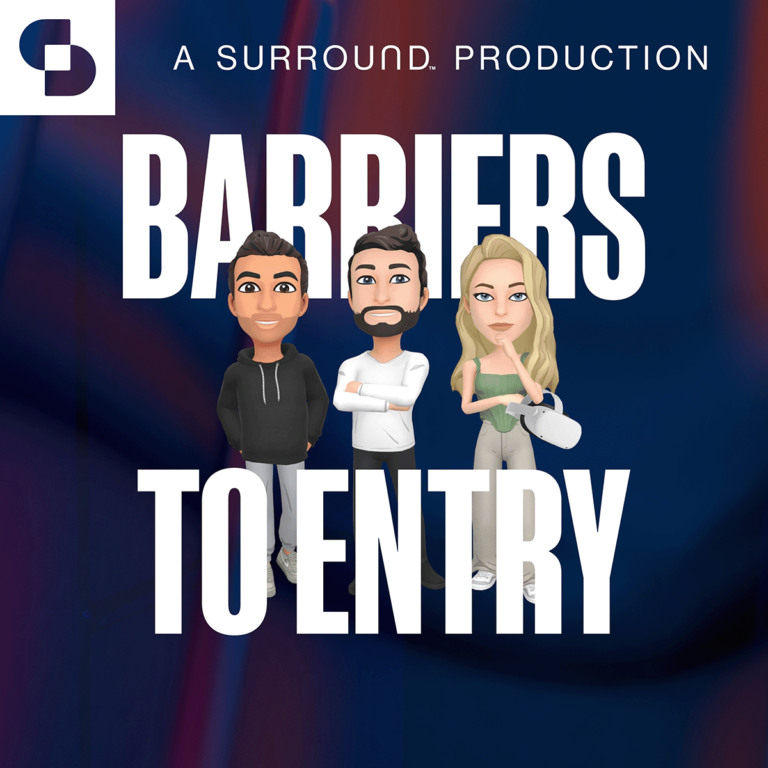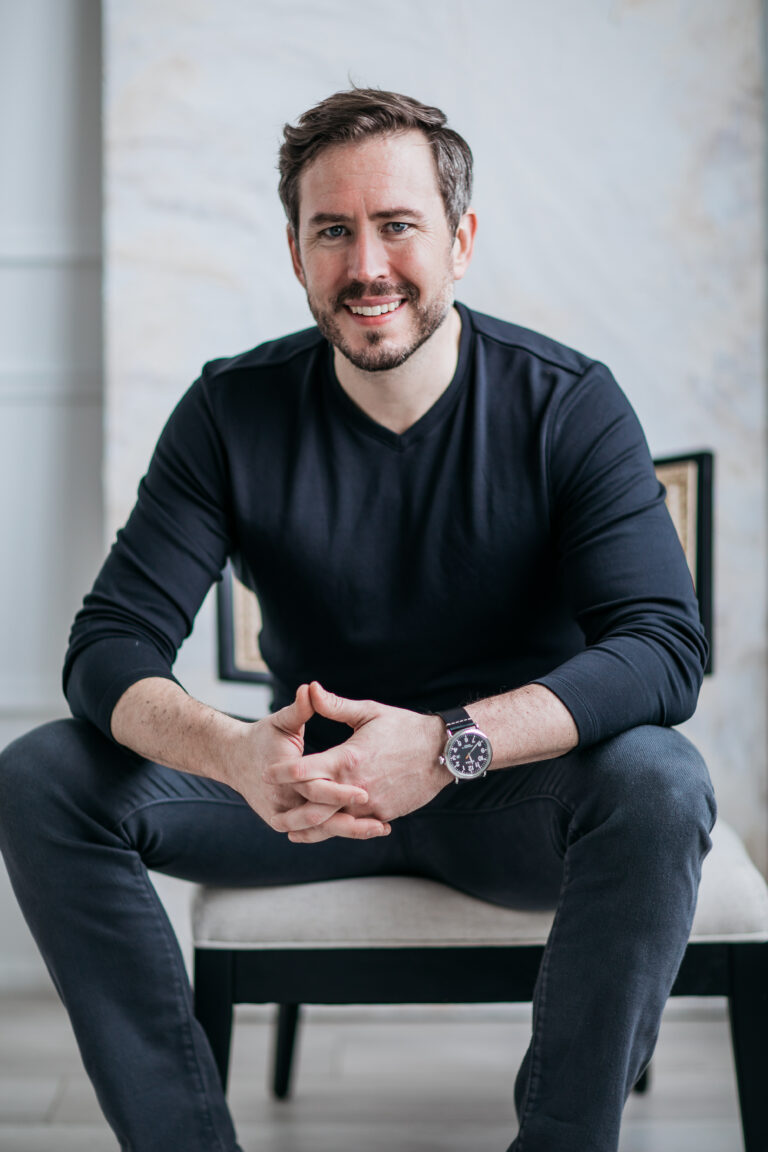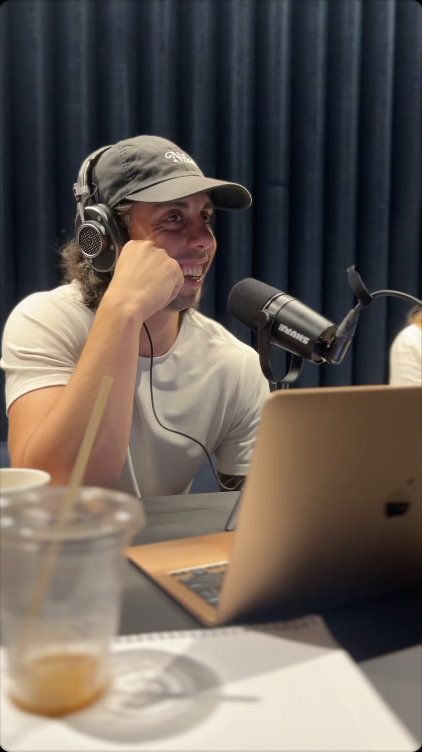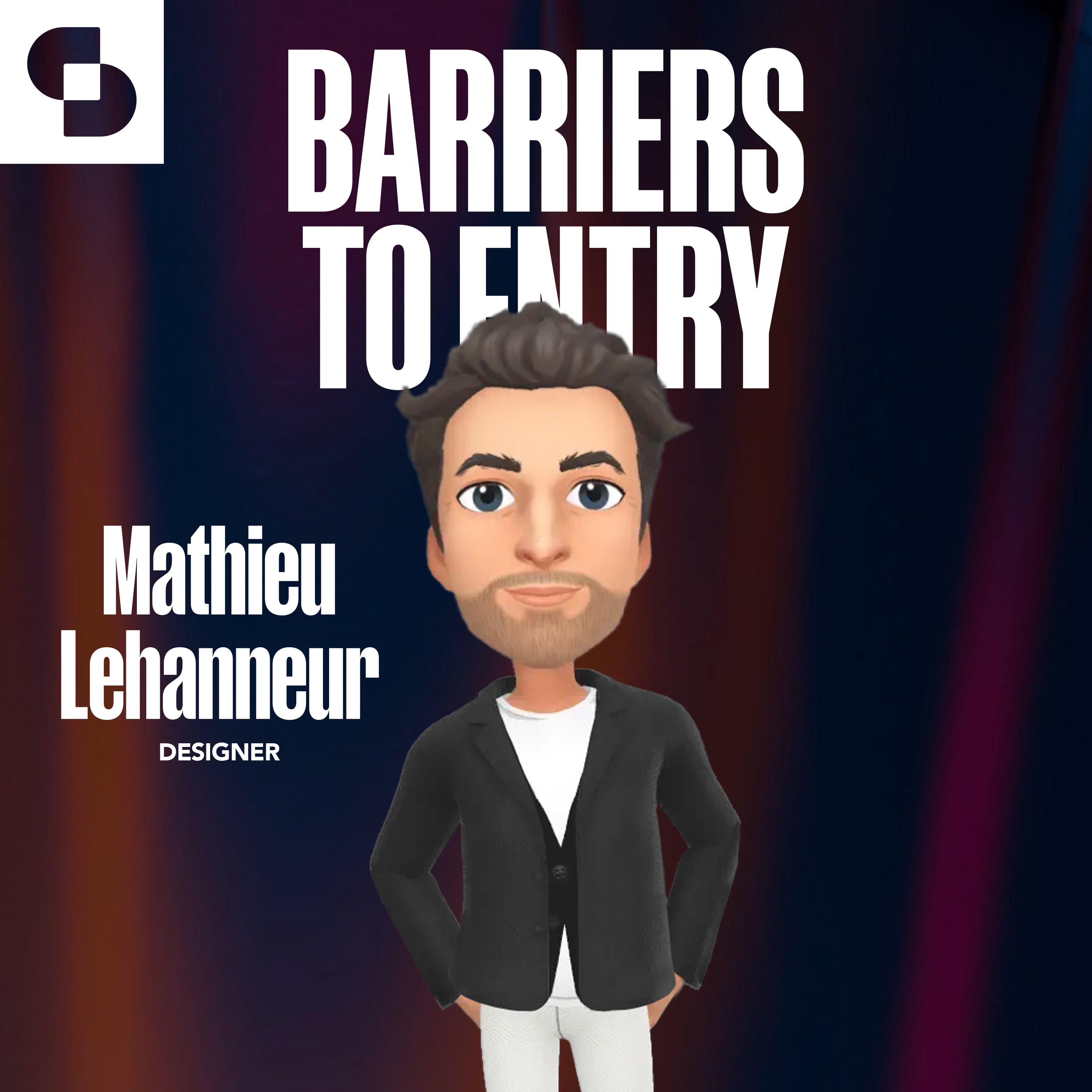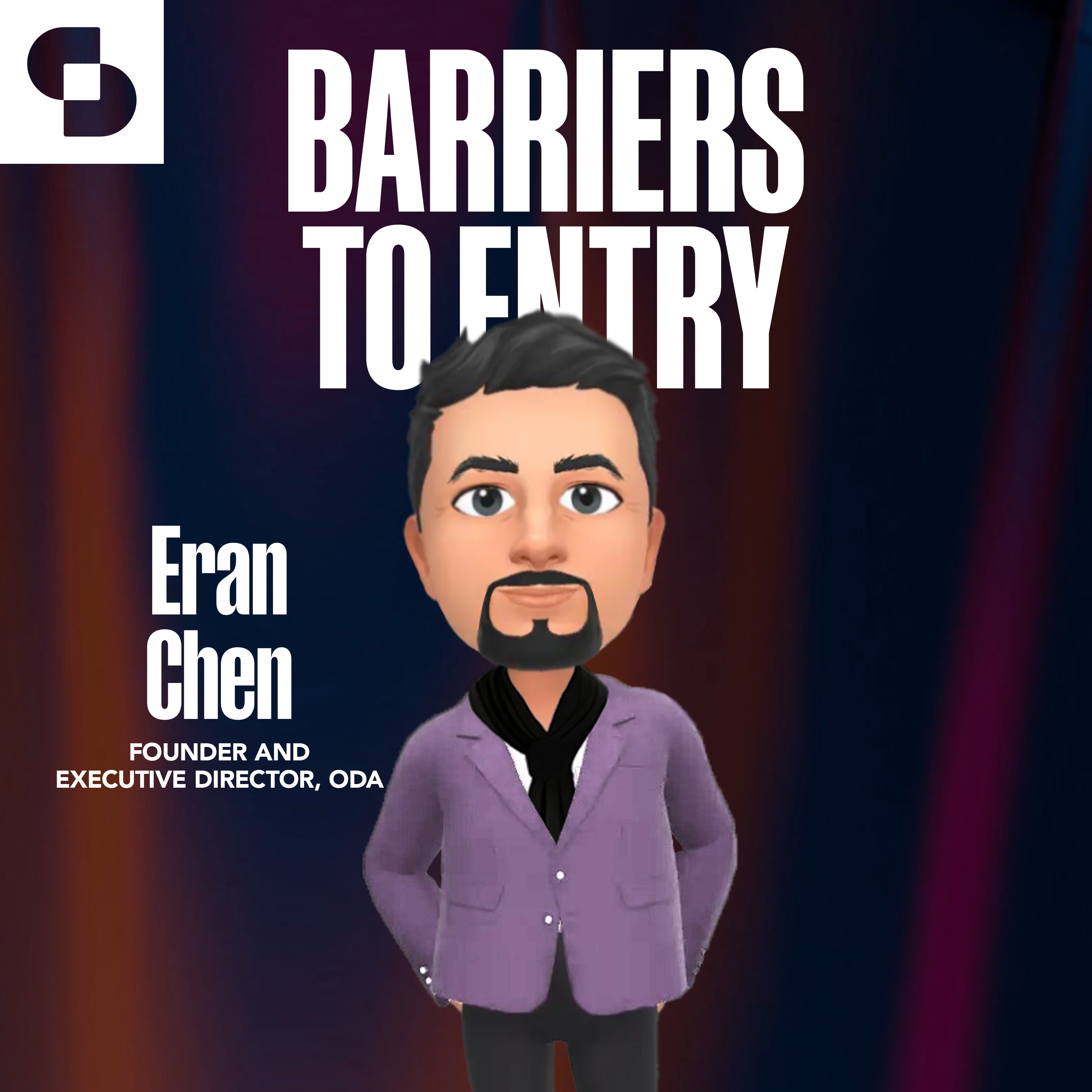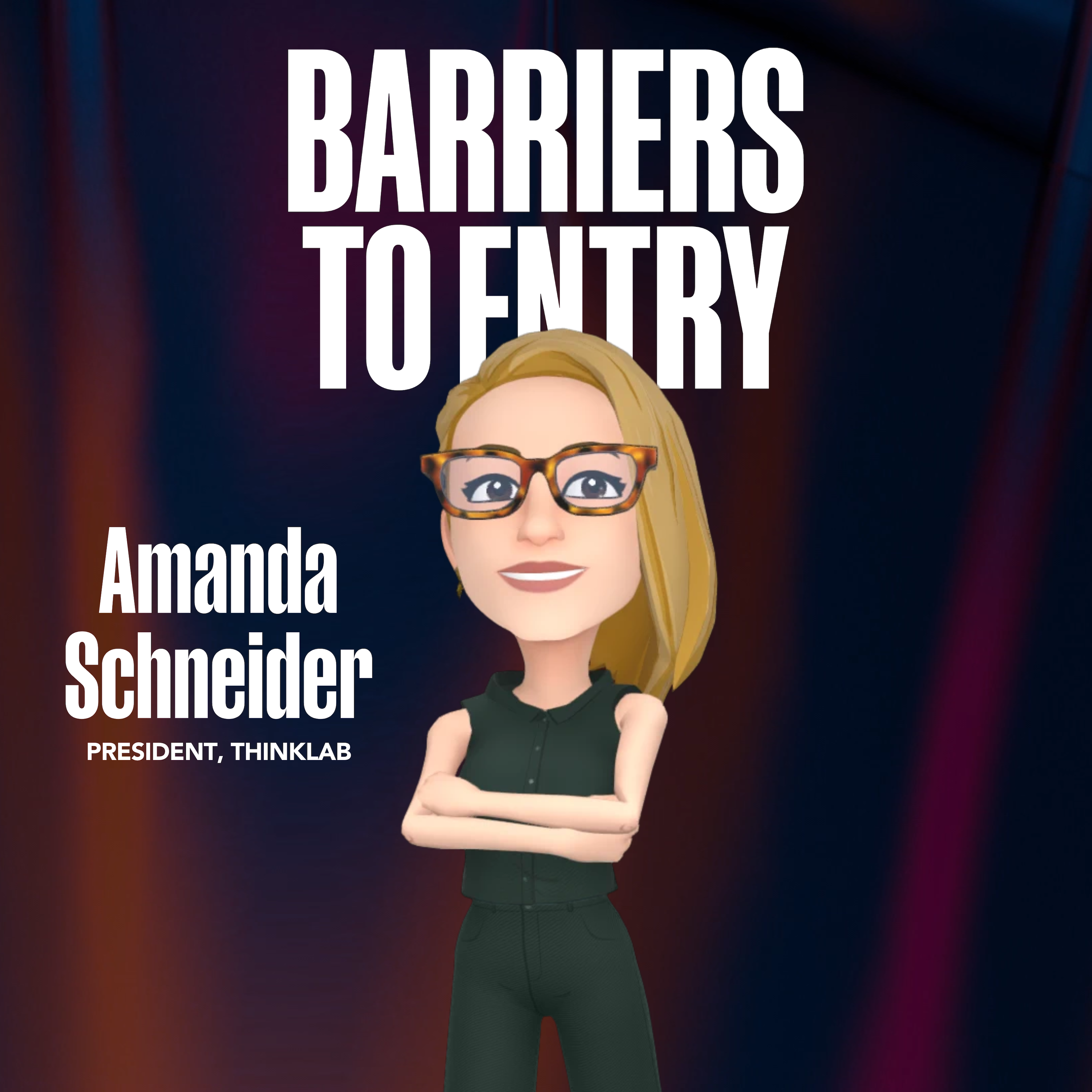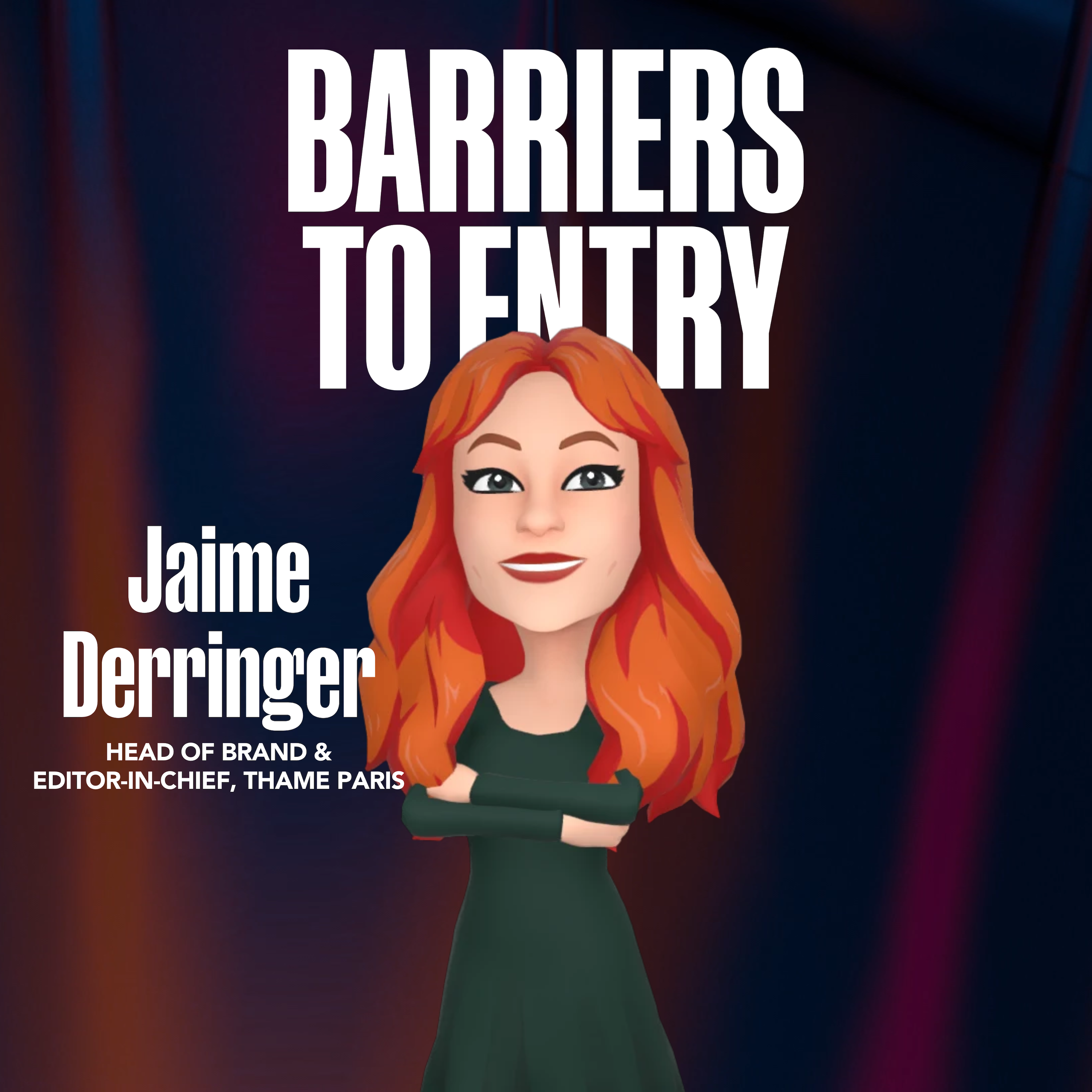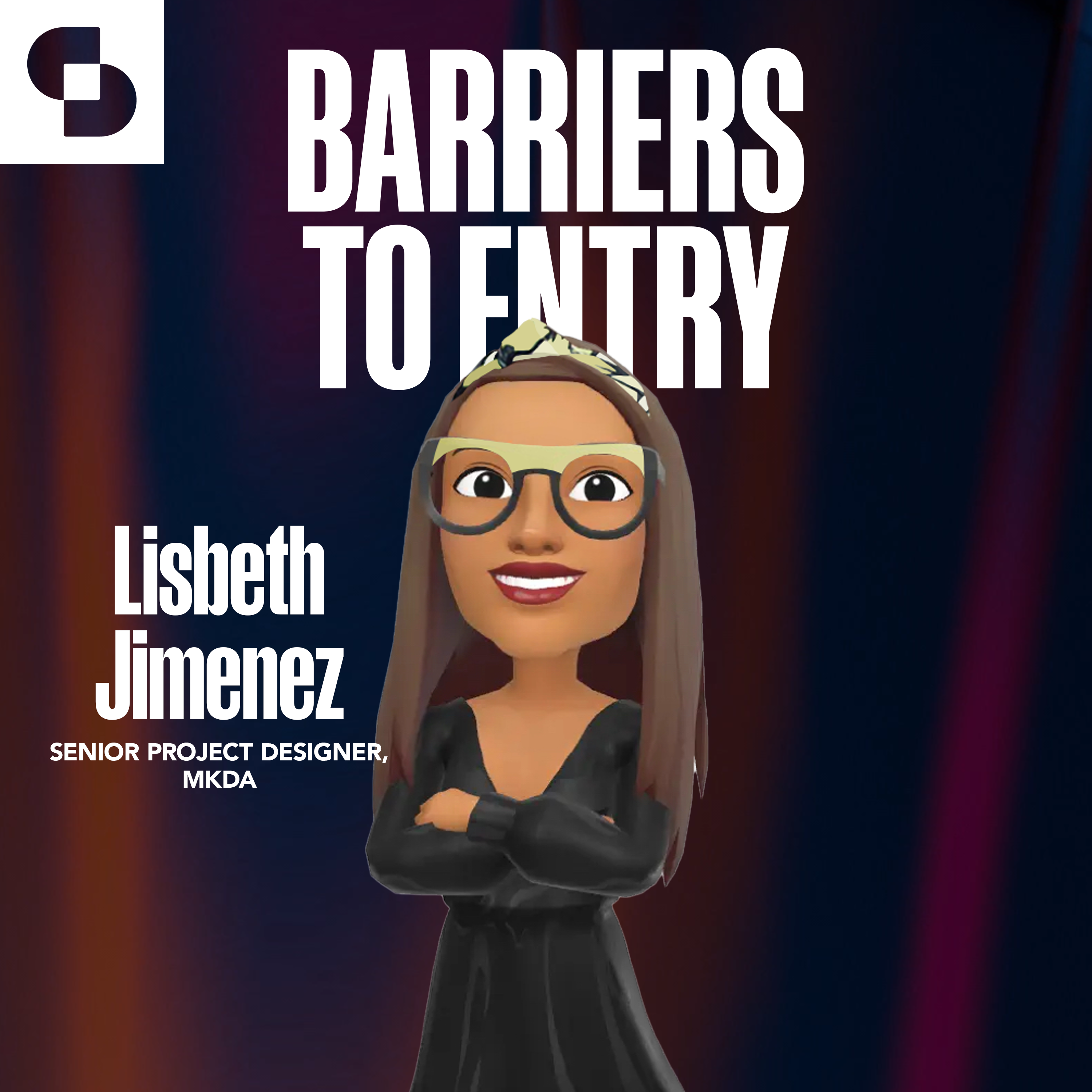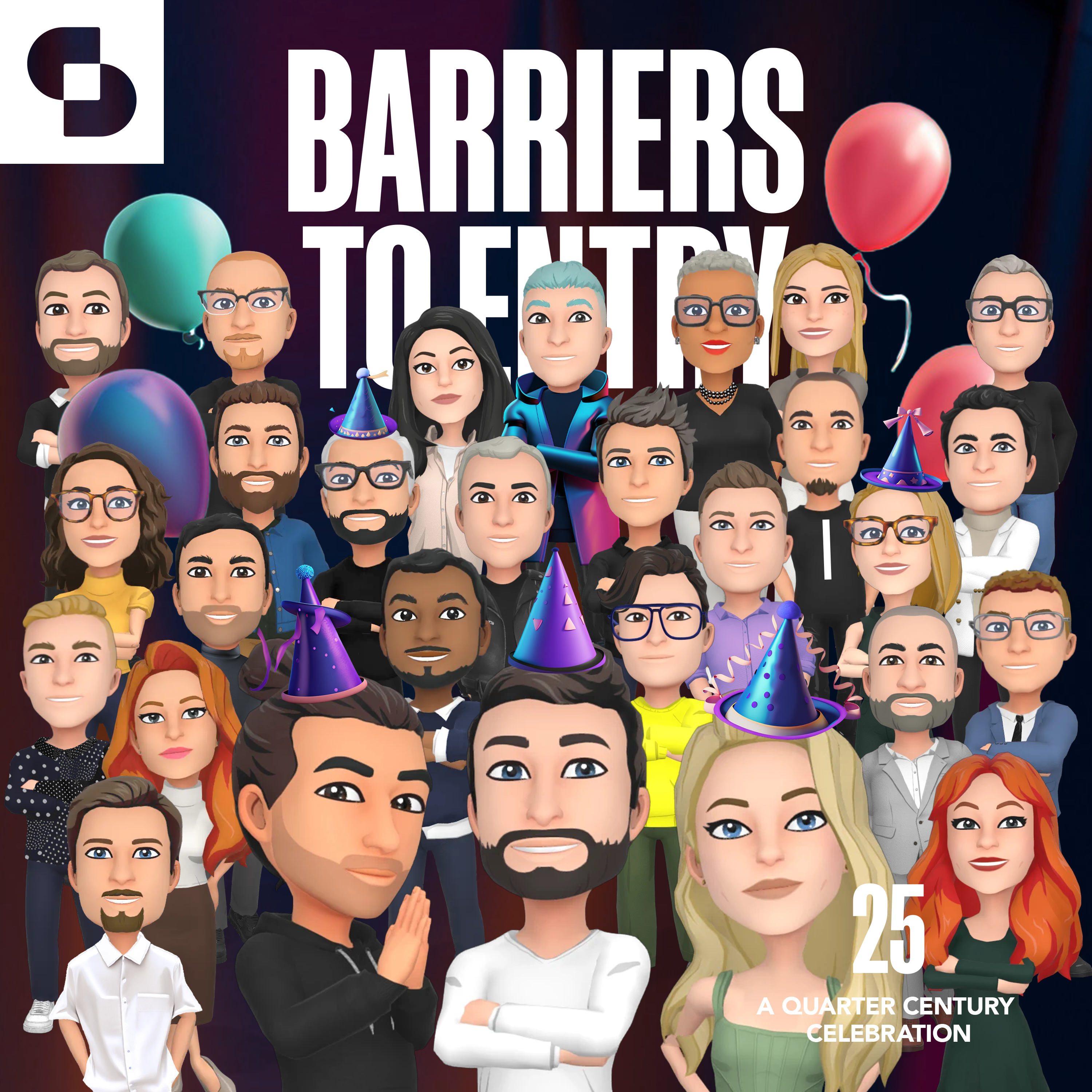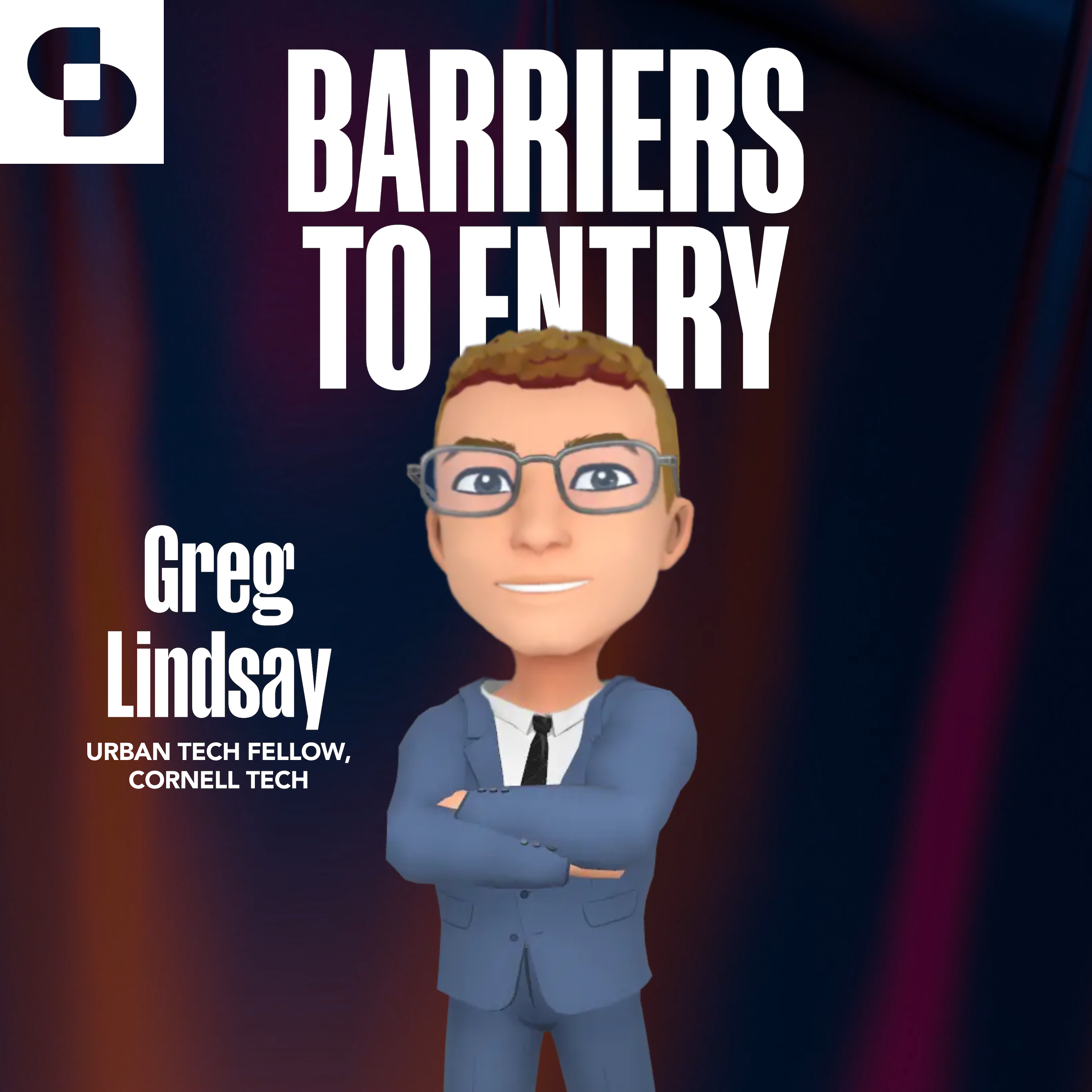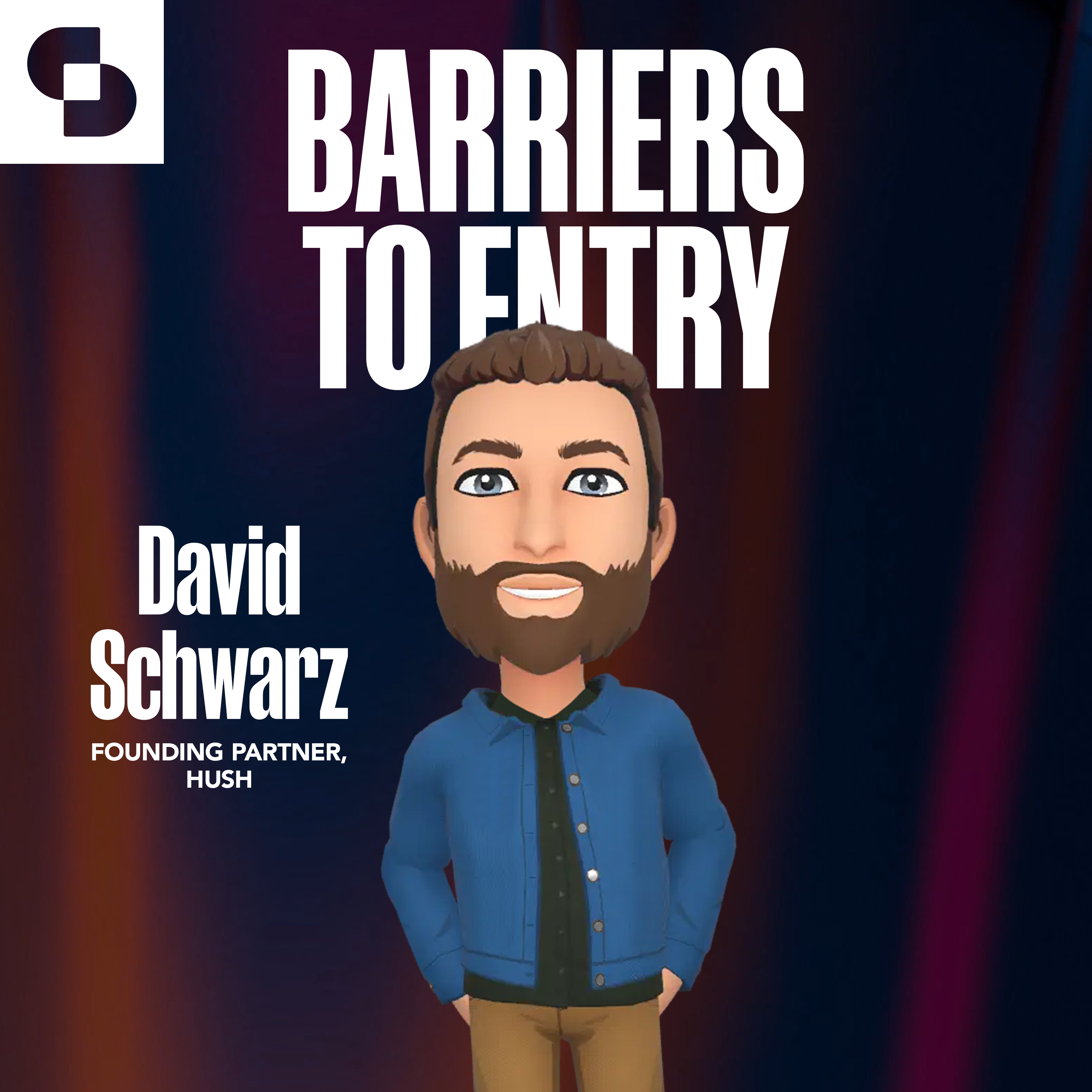On this episode of Barriers to Entry we’re joined by a true pioneer of Web3 in the design industry: Michael Beneville, Founder and CEO of Beneville Studios, Chief Creative Officer at AREA15 and the Chief Creative Officer at Vatom. Michael’s, journey into exploring the metaverse began nearly a decade ago, and he shared his insights in a thoughtful and inspiring discussion focused on the evolution of design. Michael went through the opportunities for designers and builders in the Metaverse, how folks can best position themselves for this coming wave of innovation, and even shows Bobby a thing or two about how to plug a project.
Moments to check out:
– Exploring the Benefits of Digital Twins for Businesses (starts at 11:12)
– The opportunity for design in the metaverse (starts at 15:02)
– Challenges of Adapting to a New Reality (starts at 36:57)
Connect with our hosts on LinkedIn;
References and resources:
Discover more shows from SURROUND at surroundpodcasts.com. This episode of Barriers to Entry was produced and edited by SANDOW Design Group. Special thanks to the podcast production team: Hannah Viti, Wize Grazette, Kasey Campbell and Samantha Sager.
Tessa Bain: [00:00:00] This is Barriers to Entry, where every episode we get into it with the leaders, the designers, the early adopters, and the influencers who are helping to shape what web3, the metaverse, the blockchain, and more are going to mean for our architecture and design industry. I’m Tessa Bain, and as always, I’m joined by my very captivating, very handsome co-host, Bobby Bonett and Andrew Lane.
Andrew Lane: Hey Tess.
Tessa Bain: You know, it was my great misfortune that I missed this episode. I was riding my horse on a lovely sunny Sunday afternoon, and to my dismay ended up on the ground and ended up taking about a week off in hospital getting surgery. I am much better now.
Andrew Lane: She’s ok folks Yeah.
Tessa Bain: Let’s not worry too much about me. I’m doing great. although slightly, uh, limited in my mobility of course, but that does not stop us here on the pod. so that leaves me in a position where I actually have not yet heard, I didn’t get to participate on this podcast and I am very excited and very curious to hear how the conversation went.[00:01:00]
Bobby: So we had Michael Beneville on, founder of Beneville Studios. We’ll get to his credentials, when we bring him in but, uh, I have to say last week, you teased, Amanda Schneider as a potential future two-time guest.
Bobby: If we ever have Michael on. We should make it our annual six hour marathon episode because we could chat with Michael about any number of ethical discussions, application discussions, any number of creative ideas. I mean, he had me laying in bed, awake at night just pondering, the future of the earth through the lens of web3.
Andrew Lane: His design-centric mind is so impressive. you’ll be happy Tess often you’re the one who brings us back to what the implications are for the design industry… Michael’s unwavering. On that topic. he’s always thinking about the design implications and so passionate about what he does super excited , to share it with the audience today and to share it with you too, Tess, so you can hear, what you unfortunately missed out on. And, I’d love to get your take when we get to the end.
Tessa Bain: I’m looking forward to it.
Bobby Bonett: In [00:02:00] the Meta studio with us today is a self-professed child of Star Wars and a true creative rebel who’s building a web3 empire. Did you see what I did there? He’s aware of many hats, including the Founder and CEO of Beneville Studios, the Chief creative officer at Area15, and the Chief creative officer at Vatom.
Welcome, welcome to our very good friend, Michael Beneville. How you doing, Michael?
Michael Beneville: I am very well. Thank you for having me today.
Bobby Bonett: Yeah, we’ve been super excited to chat with you and bring you on to Barriers to Entry. and we’d love to start just by learning a little bit from you about your career in design and hoping you can share your origin story.
Michael Beneville: I should start by saying thank you for that intro. While I’m a piece of building the web3 empire, we’re certainly standing on the shoulders of giants as we do this kind of thing. I don’t think anybody is truly building the one place. We’re all building aspects of it, right? It’ll all come together as, whatever the Metaverse or web through your, whatever it winds up being called will be.
My backstory,I mean, if I go way [00:03:00] back, I was born in the States, but I grew up, in eight, eight different countries, overseas, in the Middle East and North Africa and West Africa and places, and made my way to London when I was 10.
And at 14 I, made it to America finally, and then lived in Colorado, Alaska, Massachusetts, New York, 27 years in New York. And I’m out in Venice right now. And I, I say all of that just. It’s, I think it’s an important piece of the puzzle for me. I, I was exposed to many, many different cultures and kinds of ways of thinking and being before I was even aware of the fact that was happening to me.
And as I grew and developed as a creative, and as an artist, I think that has helped me. I was inside to the extent that I was an American, but I was outside to the extent that I was kind of an ambassador to America as a kid overseas. And I could see how it is.
How we fit into the world situation a bit and was just deeply and profoundly affected by all the cultures and people that I encountered along the way. And it’s given me in my life, I think a balance [00:04:00] between, a deep love and respect for old world ways of, you know, things are made, and, machines and tools that we’ve evolved and the archetypes that, that are ancient, that, that are time out of mind and how useful they are to me, at least at moments in time when we find ourselves hurtling into the future and so my mind, my heart has always lived in the balance of those two places. I think essentially I’m a futurist in that could I choose a time to live in? I wouldn’t go back in time, and I love certain periods in histories, but I would definitely go forward.
Michael Beneville: and I feel like I live in one of the most explosive and, expansive times for, humanity in the planet. And ironically, it it’s one of its most, potentially destructive also. but this is the moment I’d want to be born into.
Bobby Bonett: No kidding. I’ve lived within 25 miles of one place my entire life. So you’ve certainly traveled a bit more. And I’m wondering if there was a place, or a time or an age at which,[00:05:00] you were looking around or you’re experiencing culture and you said, design is the direction that I’d like to go.
Michael Beneville: I’d say that, uh, my earliest real memories of design really punching me in the face, in the heart would be in Senegal or Ivory Coast, where. the way things were built, the colors that were used, the utilitarian, nature of say a, a paro, like a one of those long canoe boats that was absolutely being used for fishing or whatever it was, but then brightly painted and decorated and this, cacophony of color and, and abstraction and all of that, that, that was not lost on me, especially because the counterpoint was coming to the states in the summer and experiencing, Florida and Disney and malls and, all of that, which I also am completely in love with. But there’s not as much adaptation of resources and conversion into something that might have been, intended as a flip flop, but now it’s turned into a sculpture. we don’t do found object in the same way [00:06:00] that I experienced growing up. And then I also had this mad scientist. well, both of my grandfathers were amazing builders and could create anything.
Michael Beneville: But my mother’s father, Alexander Hamilton was his name, and he was just a mad inventor. His house was like this wonderland of stuff and everything in play and in process. My parents would come and pick us up and we’d be painting the side of the house black, and they’d be like, ‘Alex, what the hell are you letting the kids paint the side of the house black?’
That’s what they wanted to paint I said, what? You wanna paint the house? Yeah. What color? Black. Okay. So he’s like, I’ll paint it back. You know? So he was that way. I think I could probably spend an entire hour talking about the first , 10 years of my life and, how it affected me from a design standpoint.
Michael Beneville: There hasn’t been a time in my life , where I wasn’t fixing, making, thinking, creating. and, people like my grandfathers and the people that I grew up with who made things out of what wasn’t intended to be.
Bobby Bonett: Right.
Michael Beneville: I mean to be constructive in to this conversation, I would say [00:07:00] that, Maybe 10, 11 years ago, my studio, Beneville Studios formally grouped together as, a group of 10 creative souls. Right. and we have everything from a book bindery to, tools that haven’t changed for hundreds of years. and in fact, there’s a book press at the studio that I think is from 1899 or something like that.
The technology hasn’t changed. If you wanted to buy one today, yeah, it would be electric, but it wouldn’t do anything different. It compresses the,
Andrew Lane: have a Gutenberg on staff
Michael Beneville: It’s, ah, we have amazing book binder, master book Binder, Eleanora. but at that time, we were building these one of a kind objects for, for families and individuals and essentially we were, we’re monks in the process, right?
We’re collecting all of the illuminated manuscript and then all the photos, all the everything. And then transferring them over to the latest technology. And as we were working with three generations of a family and realizing that the younger generation responded to a book, but responded far more to the digital component of a piece that we were recreating.
It [00:08:00] dawned on me that, you know, if video games are out there, we should be able to build. A facsimile or a replica of some world, right? And yes, it would cost a small fortune because you’d have to essentially build a customized video game, but somebody could have their own home or house or whatever, in just the same way that they have a book of photos or a, a combination of a digital object of books and the work that we were doing.
So those were the earliest stages of it. And I thought to be responsible to our clients, we needed to recognize that some new, formats were coming along that humanity was having to wrap their heads around. I think it’s taken almost up until the last two years for it to even fall on the radar of the number of people that are thinking about it today, which isn’t the world.
It’s not as if 8 billion people right now are considering what their lives are gonna be like. in 5, 10 years, I think it’s just dawning on a small sliver relatively of the world population that this is even happening. but for a [00:09:00] long time it was just a minute group of people. So to answer your question in a less long-winded way, I went searching for the architects of Metaverse and whatever we were trying to call it, the people who were building things.
Andrew Lane: Mark Zuckerberg named the Metaverse for you. Yet at this point.
Michael Beneville: It’s a funny, that’s a whole other conversation. Everybody gets to, appropriate along the way. Right? that’s the game. but anyway, I, remember even speaking with, the remarkable Strauss Zelnik, who, is at Grand Theft Auto and all these other amazing properties, and, and asking him like, would it be possible to, build somebody’s home in the video game?
Michael Beneville: And he said, yeah, it absolutely would be. It would, it probably wouldn’t even cost more than you’d think. but he said something really amazing at the time. He said, but could somebody just organize my photos for me? If we could just get that I don’t need a metaverse I would just like to be able to access the hundreds of thousands of photos in some meaningful way.
Iou know, we don’t want to all get out in front of our [00:10:00] skis. I’ve never forgotten that, that comment. It’s just like anything’s possible. But can we solve the issues we have currently before we try to build the next one? Anyway, I went on this quest to find, the architects of Metaverse and to really understand, web3, whatever you wanna call it, digital world’s, digital objects, everything, the pillars that you’d basically need to create and understand the stuff.
Michael Beneville: And I did it because I wanted to add that as a service that the, that the studio would provide in much the same way that, a little while ago, a year or two ago, I thought, oh, this A.I. stuff is pretty crazy. this isn’t gonna take over everything. It’s the next tool that we have to understand.
But it was the same way that when Wacom Tablets came out, I, holy God, wow, I got a Wacom tablet. I’m suddenly a little, bit more able to bridge the gap between the physical and the digital world and then when it became a screen and I could write on the screen, boom, the studio was young at that point, but everybody who needed one got one because just that [00:11:00] 12% more efficiency of being able to see the screen and not look here and draw there, but draw on the screen.
That changes everything. That’s where we are right now. So yeah, I went searching for it and I found some amazing people.
Bobby Bonett: You’ve, constructed, if you will, a home base for Beneville Studios, a digital twin
Michael Beneville: We have several
Bobby Bonett: I’m interested in hearkening back, and I’ll paraphrase the quote you shared before or maybe the way in which I interpreted the spirit of it, which is like, what should we be solving now, on the way to dreaming and what has, establishing digital twins of Beneville Studios, how’s that impacted the way in which you work?
What are you learning from that experience? What can other brands or other businesses learn from having a place, in a virtual world to, to congregate, at the office?
Michael Beneville: Let me answer that by giving you the perspective of somebody who spent the last six or seven years, really working to find the people to teach as much of it as I could learn in my team and I could learn, and then be, working to prove to all of them [00:12:00] that there was a need for somebody like me and us, my team, for the things that they were building, that’s a long conversation, right?
What are, what do artists, designers, have to do with building a digital platform? I think they have everything to do with it. but let me begin by saying, There’s no more effective way for a team to work together than to be in the same place looking at each other, getting to know each other, sharing the same, room, same object, same tools, different commutes to work, but all coming in the same place.
And I’m speaking as a card carrying member of a group of people that believe that the tail might be a little long on some aspects of everything that we’re discussing right now, but it’s happening
short of the destruction of humanity and thermonuclear war, and maybe even in that case, because it would be an only logical way of communicating from your underground bunker.
This isn’t a question about whether or not human beings are going to live in large numbers, portions of their lives in [00:13:00] digital realms, or in digital ways. Cuz it’s not just, it’s not just being in a world that’s a, that’s just an aspect of it. but it’s happening.
Bobby Bonett: What makes you so passionate about that?
Andrew Lane: And so certain,
Michael Beneville: anybody, what does Yuval Harari tell you? If anybody, tells you what the future’s gonna look like, they’re a liar, and, I completely subscribe to that. I have no idea what it’ll look like. That’s on unknown that is happening, that we’re transforming. we already have, We’re in a Riverside platform. I’m looking at you. We’re all in different places. We’re recording a podcast together. we’re not in the same state. Bobby, I’m not sure we’ve ever met in person and I have a really amazing relationship with you over the years. Respect you deeply love the, you know, your smile and all that kind of thing.
Michael Beneville: I have no idea how tall you are. I have no idea. The point is that this right here is already that conference. This is Metaverse, this is web3, this is already it. and the whole discussion is about how all these different tools are gonna synchronize with each other.[00:14:00]
The Vatom platform does all of the things that we’re doing right now, and you can walk around and you could be in the lobby of a place or going down a river or whatever. It adds a context and a place and all these things to it. And another platforms are working on that as well. So my certainty is that one businesses didn’t completely collapse during the pandemic.
Many survived, some thrived, and it was because of this digital bridge and this is the crudes, most simplest form of looking at a 10 inch screen back in the whenever, with zero content on it in a crackly picture. And, and anybody who told you at the time like, why the f*ck, would we need this radio’s so much better?
Michael Beneville: Cuz I can imagine it in my head. guess what turns out in 2021, radio is amazing because you can imagine it in your head and all the ways of getting from point A to point B in my car or when I’m working, fixing the sink or something like that. I can listen to podcasts and I can do all the things.
It’s perfect for that, not so perfect when [00:15:00] I wanna, watch a movie right there where I need the visual. So my certainty is not based on the world converting and living in some, dystopian V.R. landscape. that’ll happen with some people, that’s concerning.
But my certainty is this, that we don’t tend to put the genie back in. We tend to solve how it’s going to work ultimately for us. There’s the danger though, is will it work for us at, will it work against us? And that was my search six, seven years ago. It was to find the people who I felt were building worlds and the early, beachhead in this digital parallel universe who were trying to create something human-centric, and useful and, sort of noble, everything has to make compromises along the ways, but at least you could start out by saying the purpose of this is to help humanity and not to sell it down, bridge parts,
Andrew Lane: it’s a great juxtaposition. Like you’ve referenced a few dystopic ideas. and I think that’s [00:16:00] where a lot of the fiction that we’ve already seen about the Metaverse and the fairly famous Ready Player one, I think is probably the most mainstream of those fictions right now, but
Michael Beneville: I had a stack of, literally 15 copies of it in the studio. When I first read the first one. I just would hand it to people and say, this is some version of this is happening.
Andrew Lane: So you, and you’ve talked about this idea of the boundless expansion of physical space, I think was the quote that I took down that you had used. And I think that’s really apt. So we’ve got designers, you’re a designer, you work with designers. What is it that you are, setting up in terms of how should designers be thinking about the opportunity here? When you’re saying you want to do something that’s noble, we don’t want to go down this dystopic path, what are some of the principles that you’re carrying in mind and passing on as you’re thinking about building, in this boundless expansion?
Michael Beneville: Hm. Well, this is where sort of the love of the past and history comes into play, right? I think other times in, human history where we’ve faced the opportunity for boundless expansion into [00:17:00] worlds or continents and, how did we treat that landscape? How did we think about the things that we might encounter along the way? So I mean, macro big and wide as sapiens, we haven’t done terribly well, right? We’ve we’ve
Andrew Lane: Well, scurvy is less of a concern this time
Michael Beneville: Yeah, exactly. exactly. Yeah, what was it? I’ll regal you with tales of drinking my own urine and hooking the weevils out of biscuits. like that’s how we survived.
no, scurvy isn’t as big, a problem. and on one level, we’ll think to ourselves, well there’s no indigenous flora, fauna, or even tribes or people that we’re gonna be destroying, because in theory it’s all virgin land. it’s not, it’s land that is built on top of servers and digital farms and things that sit in places that are generating heat and keeping power.
Michael Beneville: And, but every single bit of this digital something has a cost somewhere. It’s not free.
Number one, just practically cost to mint, we all know, I mean, that’s a big discussion about. Mining and all that kind of a thing. So it does have a [00:18:00] physical impact on our world.
It has a mental impact on our physical world because the threat is that it divorces us from the world that we’re in and puts us into another reality. Even if that’s just that we’re walking around with our augmented glasses on and seeing a different world than the one that we’re walking in.
And if the city looks clean through our A.R., is it really clean if we take it off? You know, all those kinds of things are we seeing around people that we should be encountering, on and on. So, the answer to the question is this.
Michael Beneville: I think that we have always been, I say we, designers, creators, architects, builders, the folks who painted on the cave walls, the ones who stack the firewood in a nice way because it looks more becoming, like whatever the heck it is, like making our caves better. that’s always been our role.
Our role has been to bend reality. The reality that we look at, into something that is pleasing, inspiring, and hopefully comforting to the human being. Right? And the responsibility at the end of the day is to try to do that in some way that [00:19:00] doesn’t, completely destroy the cave of the people next door or whatever it is, right.
and it’s no less true here. the artist, designers, creators aren’t gonna be the ones who are writing the code. or creating the incredible, I sit in these meetings sometimes with the Vatom team and I just cannot believe that somebody sitting and just tapping their fingers out can build all of this, like the, the plugin architecture that allows you to create anything now, not in five years today.
Michael Beneville: That just blows my mind. What we do with it, how we use those tools is really the next piece of the puzzle. Philip Rosedale was Second Life. he’s a very good friend. He’s foundational to our work here. and I mean, he really just created something incredible with Second Life.
But what we see is gonna be what we put into it. And I think that for human beings to respond positively to this new world. We all have to be midwives to that process and make that moment of transition, something [00:20:00] that is not abrasive and hard. We know that it’s difficult for some people to put on goggles and, instantly be in a different world, right?
Michael Beneville: It’s disconcerting if you do it to a 10 year old. Maybe it’s a little bit less than to, a 20 year old, to a 50 year old, to a 60 year old. Should you be doing it with a 10 year old at all? Should a child be, have the right to grow up without all of this stuff up until a certain point?
I think those are huge questions, but what we see and how we see it, is absolutely critical and it’s visual designers we will build this world at first based on our understanding of the world we live in currently. and then other things like how video games have worked, et cetera, et cetera, et cetera.
What will then happen is a moment where we realize we are not bound by these parameters in much the same way that photography is an evolution of painting. It doesn’t replace the portrait, it’s just a different kind of portrait, or that film is an evolution away from the play. It doesn’t [00:21:00] mean that we don’t enjoy plays and that they aren’t a remarkable, way of seeing something.
Michael Beneville: But when a film comes along, it allows you to do jump cuts and flashbacks and all of these kinds of things. What a film allows you to do is to see something visually the way that we dream. What these technologies allow us to do is to get into introducing digitally a true dream state, into our lives and man, you want a nightmare or do you want to, wake up, smiling.
Bobby Bonett: there’s some scary stuff in there, throughout. I think we, we balanced the opportunity with what the flip side might be. But, one thing you had mentioned, Michael, and we’ve had this conversation with a couple of guests, how it might be natural or much more natural for a 10 year old who’s grown up with this technology, to put on a headset, let’s say, or to enter into a metaverse than somebody who’s 40 or 50 or 70 years old.
And so I’m wondering what your, approach is when, designing inclusively for a metaverse. if we are, sprinting toward, this technology continuing to play a really key role in our lives over the [00:22:00] next five or 10 years, how do you make sure that you’re designing environments that everybody can enjoy, not just a technophile or not just somebody who, feels more comfortable entering a space.
Michael Beneville: Yeah, that’s a really important question. I’ve said in the past, and I don’t know whether I. Heard it somewhere, or whether it was original thought that metaverse really isn’t, or again, web3, these fundamentally aren’t designed for the wealthiest and most privileged, it’s quite the opposite.
The wealthy and most privileged already live in a metaverse, wake up every day and it’s beautiful and it was designed by whatever. And, no, no objection to that. That’s not the point of the comment. It’s just that, if your needs are taken care of and your world is beautiful and the work that you’re doing is important, but not based on having to, achieve that, you’re already in a metaverse.
And I’ve said it in the past also, which I think is crazy, that wallpaper in the 18 hundreds, the introduction of that, Was something that put into the hands of not everyone, but into the, this new sort of burgeoning,[00:23:00] industrial class, the ability to have in their rooms and homes, something that was reserved for, a, a king or a noble, unless you were yourself, the painter, right? Any painter could go and create their own mural, and live in that. But that’s a, that’s metaverse right there. That’s the expansion of the walls through the use of wallpaper and technology, because the scaling of that and the printing of it, et cetera, revolution, allowing that to fall into the hands of somebody was the ability of a more regular person to expand the walls of their humble abode into something that would look like what the noble’s had.
Michael Beneville: And I think that’s where we are. So a bit of all of this is not, the miracles are being developed on incredible computing systems and, with enormous bandwidth and things that look absolutely real indistinguishable from reality. I’ve had a chance to see a little bit of in, in my travels and it’s just, it’s mind blowing where we’re heading and one day that’ll all work its [00:24:00] way into, costing 99 cents and being downloadable on everybody’s, whatever we’re using then.
but it’s not now. And I think for me, I’ve always enjoyed looking into the future and flight’s a fancy and what will happen next. But my team and I have always been grounded in what could we build and do today. Which means that when I found Eric and Vatom and the team here, they were building something that you could use today. It’s web3 platform, metaverse building tools, intelligent digital object, minting, all of these things that not just work today, they also work today on laptops that people own phones that people have. And on beyond that they’re web-based, so that it’s not as if somebody has to have a $2000, $3000 computer with all these chips, et cetera.
If you wanna build something that’s inclusive, you gotta build it for billions of people. And right now, . And so I think [00:25:00] the biggest thing that we can do for, to be inclusive is to develop technology that millions and billions of people can use rather than a handful.
Andrew Lane: It is curious though, like you could call it an arms race that’s starting to emerge around designing for the physical and designing for the digital. as you’re sort of articulating a lot of the principles are common, but how do you see this starting to play out and where do you see, designers lining up to participate and position themselves, as this, starts to emerge as a trend?
Michael Beneville: You know, the thing that pops into my mind is, my project Area15, first one we have is in Las Vegas right now. Millions of people have visited it in the last two years since we opened it.
Andrew Lane: Bobby, you should be taking notes on how to plug things. Michael’s is actually much more elegant at this.
Michael Beneville: hey, I was born and breaded at a cocktail party, Andrew . but the reason I bring it up is because the thing they think that we solved at Area15 was how can you plunge people into an alternate [00:26:00] world, a reality, an immersive world and an analog immersive world, right?
Not necessarily a digital one. Chris Wink created Blue Man Group and his fractal mirrors and all of these things, or Meow Wolf, which is our anchor tenant there. the design challenge for us was when you leave something like that, where should you be If you’ve been transformed, right?
Why should you be back out in a parking. Or, you know, next to a blah, you want the dream to go on, right? so one of the things that Area 15, I think solves is how would you build a district of all kinds of immersive experiences and how is them in something which becomes the connective tissue between one to the next so that you don’t drop out of your state of, happiness and call it vulnerability or whatever it is before you embrace the next thing.
Michael Beneville: And I think that’s a real challenge for what you were describing as, as this arms race. It’s a positive arms race in a sense because it means that if we go into these [00:27:00] virtual worlds or our augmented realities or whatever they are, when we step out of them, We should want the world around us to, to live up to that expectation and be more beautiful.
Michael Beneville: Now, you can’t walk through the redwood forest or a jungle and think that we’ll ever get to creating anything as magical or as beautiful as that. So in essence, that’s what we try to create. That’s what Cameron’s trying to create with Avatar, right? It’s like, how could I make a digital version of this insane beauty and make it feel as I walked through it, right?
So that I think is really interesting is that, as architects and designers begin truly developing in these worlds, what’ll happen is that these impossible buildings, which are never could have been built, and just structures and ways of moving, et cetera, will be built. And that will push the envelope of just how, what we expect in our real and waking lives.
But that’s already happened with sci-fi and everything. look at Bjarke Ingels, right? he’s the most amazing architect, amazing guy. Look at what he and his [00:28:00] team are building is impossible to imagine without all the sci-fi and things that we’ve grown up about. you could see it right there.
And that, that’s it. that’s what I’m talking about, is that our real world will start to live up to that and that world will always try to be catching up.
Andrew Lane: I love the idea of them complimenting each other and pushing the envelope forward. in our pre-call, you talked about the idea that there is this parallel world that’s existed for 40 ish some years and we’re just now starting to pour into it on mass. Like how do you see that manifesting itself?
Does that accelerate the kind of, experience and trend that you just described in terms of, the complimentary inspirations? Like what other impacts does that have that we have just so many more users now, who are starting to appear?
Michael Beneville: We will need to be thinking of public and private spaces as things that are bridges and portals to virtual, and immersive spaces and ones that are, seamless in their feel. ultimately maybe [00:29:00] indistinguishable. I don’t know whether we’ll live to see that. and I I don’t mean that in some sort non-practical way. we we’re already living in this place is, I guess what I’m gonna say. Just the tools through which we view it and see it are crude and but developing at a lightning pace how we use them so that we get a seamless, non bumpy, non lurching ride will be it.
But I read once about something Norway or something and we’re talking about. , what is the social, what are the social graces around the fact that you have a communication device in your pocket? Plumber turns up at somebody’s house, she answers the door, he’s on the phone with his wife. Who in that situation, in a modern age is more important? The conversation he’s having with hi in his ear, with his wife, who is the, person he’s married to, has kids with blah, blah, or his client, and the person that he’s there to fix the toilet. Now, in his mind, he’s thinking, I don’t need to talk to this person.
I just need to [00:30:00] fix their toilet. It’s not a friendly conversation. I don’t, this is more important for me to be speaking to my wife about this crisis that we’re going through and to not be late. For fixing the C clogged toilet for the person. So these are these questions about what reality we’re already in.
these are these choices we’re already making. is it more important for me to be answering this text message at the dinner party when I’m sitting next to five people that I could be talking with? Or is, should I be engaged in this reality? This is all set up. It’s only gonna get way more complicated.
Michael Beneville: And I know if Emily Post has, an answer for us right now, my answer would be, get off the phone with your partner. At that moment, you finish the call, you work out your life in a such a way that when you’re there for your client, you’re present and all those things. But I’m, I’ve got silver hair.
Bobby Bonett: Is that actually the priority? You know, like, we had a conversation with Josh Rubin and Evan Orton from Cool Hunting, and Evan and Josh were both such advocates for when you’re on an airplane, [00:31:00] Open up the window and just look outside for a couple of hours and, but to me, I hear . I thought you were gonna ask Andrew and I to answer the client or spouse question.
Bobby Bonett: I was glad it was rhetorical, but for me, it, it’s so hard for me, like even if I’m at an incredibly interesting dinner party, not to follow the instinct to reach into the pocket, check the phone, look at the Apple Watch, have the other, existence that, that exists outside of here, and not just focus on that moment. That is a fleeting moment.
Michael Beneville: And this is why the bridges and the ways in which all of these things happen are gonna just be the elegance here. This is what designers and architects and people will do. They, we already give visual cues to how you should behave in a certain environment based on design.
Andrew Lane: And we’re increasingly like a society of multitaskers with people who are used to multiple screens coming into the workforce and, becoming the primary consumers over the next decade. I think that idea of having parallel attention spans is a really interesting design consideration as these kinds of [00:32:00] integrated experiences.
Michael Beneville: What could you design that would make somebody walk into the space and put away their thing and be, oh my God, I gotta pay attention to this. That’s that sort of arms race between the realities. And it is one because the digital thing is always gonna want to be calling you back too, and saying, yes, but you could see it with even more stained glass windows if you did this.
We’ll, we’re gonna be toggling through all of these realities of saying, eh, I just wanna see it. I wanna see the roof the castle as it was. I wanna see it as it is. Oh, I want to see it as it is with all the people running in and out of it. An affair happening in front of it but now boom, I’m just back in Wales standing in front of a Ruben Castle. that’s not far off. You can already do that holding the phone up someplace. And we could embed a bunch of Vatom’s and digital objects for you to run around and pick up objects and, all that kind of stuff.
So what is it to visit this actual place with all of the augmented artifacts and things that you could [00:33:00] be, and how would you leave behind your digital thing of I was here, and when my son is, 20, I’d like him to come back and remember when my son is 52, I’ve, I have left a message right here, for him,
Andrew Lane: There’s a real challenge there, I think, for designers when you’re saying to create something that’s so compelling that everything else can melt away and you can be comfortable with that. Ironically, I think being on a podcast is one of those mediums where you’re almost always doing something else when you’re listening to a podcast.
Andrew Lane: You rarely hear of people saying, I’m just gonna sit down and really listen out that podcast. It’s no, you’re on the train, you’re grocery shopping, whatever. And I think probably the rise of this form of media has a lot to do with how it can be both active and passive at once. So it’ll be really interesting when we start talking with these media types that are.
Intentionally much more active and engaged in order to get the most out of them. And to your point, how do we design in such a way that people will be okay with that?
Michael Beneville: Yeah. Yeah. I had a wise, wise teacher, Michael Howard, many, many years ago. He, I indicted in his late nineties, [00:34:00] but he said you, you do not multitask. you are focused on one thing at a time, and everything else is, beta to that one thing. It’s just that you can swap in between the things that you’re doing, but one is definitely diminished.
If you’re driving the car and the brake lights go up in front of you, you’ve gone from thinking about what you’re gonna have for lunch today to, hitting the brakes if it’s an emergency, or it’s just resigned to habit and habits a different part of the brain. But that is this challenge here for designers is, exactly, it’s how do you create and build things that that invite you in and embrace you when they do that, let you know where it is that you are so that you can function better in the space. There is an entire world to be built, not even a world, a universe, like beyond a universe. it’s on and on forever and ever.
Michael Beneville: So what we do with that and how we take the first steps to, to making us comfortable because we see vestigial design elements that are the things that, [00:35:00] that ground us and then set ourselves free from those things and think how would we actually move through time and space if we weren’t limited by our, the that you come into the world with. You know, your eyes and your ears. If you don’t have those, how you work around them, that’s this, that is this challenge. And it is incredible because we are introducing a state of reality, that this hasn’t been before.
we’ve been able to dream, we’ve been able to think, we’ve been able to transport ourselves through books and, intoxicate ourselves. We can meditate, we can run, we can do all of these different things. We can watch movies and everything is our mind, letting us know you are actually sitting in your armchair watching this movie.
Michael Beneville: You are actually in bed reading this book, but you know where you are. that’s what it’s been for our entire time. Now we’re in a place where the opposite is true. Our brain can be put into a place where it’s having to think, where am I? Am I actually still sitting in bed? Am I in a conference room?
Am I walking through a grocery store? You know,[00:36:00] what’s real and what isn’t big challenges. and so was building with steel, so was making a building that was taller about as tall as a building off to go. oh my God, it’s gonna be 20 feet tall. I got to work on the Empire State Building with Tony Malcolm when he redid that and the incredible team there that we have to remember that it doesn’t seem possible for anything to be that tall.
and there’s elements of it were overdesigned even though they knew they didn’t need to because no human being would get into it if it didn’t have this, dimension of steel column and this many rivets and this many whatever. Even though, Bjork will tell you could build a building with, , a bunch of different, newfangled things.
Andrew Lane: Plywood skyscrapers.
Michael Beneville: Are you gonna be comfortable in it? that’s where we really come in. Is it gonna be useful? Will you be comfortable in it? Is it for us? Is it for humanity? Is it for, is it human-centric?
Bobby Bonett: You’re so pragmatic, [00:37:00] but also, you know, so thoughtful and, have such a visionary mindset about, what, what lies ahead of us in this technology set.
But I’m wondering, to borrow what you had said earlier, if what we’re doing right now is proof that the ways in which our lives will continue to be, intertwined with digital spaces, just by virtue of us being on call. How do you contend with people? Hate this lifestyle, hate being on Zoom calls all day, hate the hybridification of work and have such a thirst for only being in person and being done with these technologies, which are probably bridges to greater technologies.
People are impatient and what’s your mindset to combat that in patience and stay the course with your vision, for what you’re doing at Beneville Studios in Area15 and Vatom.
Michael Beneville: I’ll answer by saying something which may sound confrontational or may sound, un-kind or may sound on non-inclusive, or, as we were talking about earlier. But I, it was said to me once [00:38:00] by, a wise person when we were, in the early months of several years ago of launching one of our one of our Vatom Worlds, 700 people were gonna be coming into one space, not split into shards, not anything like that. That was at that time, 700. I think we can do thousands now in one instance. But the concern was, hey, these are 700 really, powerful people who all need to connect and they can’t during covid.
Michael Beneville: And this is a new technology and what’ll happen if, 5 or 10 of them can’t get in or whatever. And I, that was my biggest concern, and that is most people’s biggest concern was like, oh my God. But the guy who was commissioning this whole thing, which himself, he himself is in his late sixties, he said, you don’t design the future for everybody at a certain point, somebody’s just not gonna get it and not gonna want it.
and you can’t design the future. If every single person has to be able to access it or else you’ll never take the bold steps of just creating. The next piece of the puzzle. It doesn’t mean that they’re not invited to. It doesn’t mean that they’re not welcome.
Michael Beneville: They are, [00:39:00] but are they going to take the time to work out how to move in this new space, how to do all of this new stuff, how to, whatever, when Zoom came up and teams and all these things during Covid, we’d been using it for some years because we were distributed and around the world and all that.
But for a lot of people there was a hell of a learning curve right there, of just thinking, oh my God, what am I gonna do? And there were a few people who just said, no, this is not for me. That’s okay. By the way, Bobby, I know you’re gonna outlive us by 75 years or something. I hope that I would live to be a 100, 130, something like that with the caveat that I hope that I do that with, essentially feeling the way I do today.
The importance of what I’m saying there is that I know that I will die in a world that is completely unrecognizable to me, that won’t even be able to compute the fact that I didn’t, have a computer growing up. I know that there will be at some point in my journey, no matter how far I look into the future, a world will happen that [00:40:00] I just don’t need that implant or don’t want that thing or whatever, because it’s gonna be so far away from who I was materially in my core and my soul, that it’s just that next step isn’t the next step that I want to take.
That’s gonna happen to all of us. this moment in time is about thinking where do you get on and where do you get off? And that’s okay. you should have those choices. Doesn’t mean it shouldn’t be open to you, Apple does an amazing job of serving it all up in a delicious way. It is a miracle, how well it’s done. Disney does the same. You don’t even need to add gas or change the oil.
Michael Beneville: You just point the car in the direction and off you go. Right? Anyhow, did I answer that
Bobby Bonett: Yeah. Uh, uh, amazingly articulated. So Michael, we wanna give you a chance to, talk to us a little bit about what Vatom’s up to right now. if there are any projects that, that you want to share that, either recently completed or in production right now because it’s really an incredible technology and y’all have already, had several amazing partnerships.
Michael Beneville: Yeah. Thank you. this is my Letterman moment where Letterman turns the question over. that is a platform which, I’m involved with it because it, checks a lot of the boxes, that we’ve been talking about today.
It’s something that is built for artists and designers and creatives and firms and companies and agencies, et cetera, to be able to have a wide suite of tools, a platform upon which they can enter web3, metaverse, et cetera. We believe there are three major pillars that are necessary for all of this.
And one is identity, you need to be who, it’s that you are. Two is agency you need to be able to move through this digital world, the environments that were in the web, basically. and then third and most importantly, to Vatom, you need a wallet. And a wallet that’s yours. A place where you can collect all the stuff as you go.
Those are three incredibly important pillars of any, all of this discussion. And it needs to all be interchangeable and it needs to be as [00:42:00] interoperable as possible and play nicely and friendly with everybody else’s systems, et cetera. so that’s what the, that’s what the platform does.
Michael Beneville: And it’s ha has allowed groups as disparate as State Farm and, Proctor and Gamble and all of these folks as they dip their toes in the water with how they want to enter, these worlds and participate. It gives them a wide suite of tools, that, that allows ’em to do so. That’s super important. Adam’s the only platform to my knowledge or to our knowledge that can have thousands of people in one instance or space. Thousands, all communicating with each other in just one, call it world, and be jumping to all of the other ones. And, that’s just in incredibly important.
so it’s an invitation, I suppose, for folks to get in and kick the tires on it. While there are incredible, worlds out there that are being built, if an artist or a designer has to adapt to the design methodology or archetypes of another world, meaning that my characters are gonna have to look this way, or my world’s gonna have to look this way, then [00:43:00] that’s fine.
Michael Beneville: It’s great. any company would want an outpost in those places, but no company wants to be in somebody else’s website really. Every company needs to be able to say, if I’m a bank, if I’m a store, if I’m a whatever, the world that I’m in needs to look like my brand, my thing, my whatever. So I’ll put an outpost in this other world that millions of people are going to. But at the end of the day, what all of this is about is that there will come a point in time where every single website still functions as a website, and there’s a come on inside button next to it, and you’ll click on that and come on inside.
Might just be giving you stuff in your wallet or come on inside, might mean that you’re speaking to somebody about, the backhoe that you want to rent for, whatever at the Home Depot or whatever.
Andrew Lane: Backhoe Metaverses are blowing
Michael Beneville: It’s true. I, the last piece of all of this, I’d say is that habit and the human habit is going to be the hardest part to crack.
Why? Why? Why will we go in? When will it become human nature to be [00:44:00] waiting for your subway car, the Uber, or sitting down in a restaurant? when will it be habit to just say, oh, I just sat down, or, I have a second. What’s around me? What can I interact with that’s not in the world that’s already around with or, and it’s maybe driving with it, if there’s a champagne bottle floating above the table and it’s feels as if it’s an extension of the world that I’m physically in that’s cooler than just some, frigging coupon that’s floating up in a nice lounge.
I don’t, who wants to see the, like a crappy, coupon for a grocery store item when you’re sitting in a slick lounge, waiting for your cocktail and your day to arrive. Yeah.
Bobby Bonett: Cool. Michael, we always end the podcast with one question that Tess ordinarily asks, but Tess is laid up today. so in her name, Andrew, I was wondering if you wanted to ask our parting question to Michael.
I don’t know if I’ll nail it quite the way that she does, but, Michael, we always wanna know, what advice would you give or resources would you share with our listener out there who’s looking to get into the space or even just understand it a little bit better?
Michael Beneville: Oh, that’s a great question. [00:45:00] Don’t wait right now. do it with the tools that you have access to, because it doesn’t matter whether the first things that you’re doing succeed or fail, for this discussion, what matters is that, that we begin to acclimate our minds to the possible.
And if we wait for three or four or five years for other people to do it and serve it up, that’s fine. It’ll just get easier to understand it in some ways. But think if you want to be part of one of the largest, design and construction projects in human history, right now is the time to do it. And just dabbling in all the different platforms and, jumping into, worlds seeing what it’s like and all the tough questions of like, why doesn’t it work? There are more reasons that it doesn’t work and isn’t useful than there are for reasons for why it does.
Michael Beneville: And I think being part of cracking the code somewhere on all the little aspects of why it does resonate with human beings, why it is useful, why it does check all those boxes. The only way of doing that is to be in [00:46:00] the mix and in the game of it. And by the way, if you’re an artist and designer, creator, architect, you’re already doing it.
You do it in physical spaces, you work on Rhino and Revit and Sketch up and all of these things. those are importable worlds. You literally just drop it into a platform. like that, or, and others too. And that’s the model. there isn’t any reason that we shouldn’t be meeting on the sketch of the floor plan and the next meeting on the built out version of it.
Michael Beneville: And not because the client’s sitting on one V.R. headset surrounded by 10 other people from the architecture firm. But because we’re all in there, all the trades and the client and the whatever, and there are a hundred people walking around the floor plan and working out what are, what’s going to be going on.
And every week it just gets more and more. But the, and the floor plan is for a physical space and a real thing that’s gonna be built. But it’s also the digital twin at first of what could be the virtual space. And then that virtual space goes through a deconstruction because it doesn’t need [00:47:00] walls and halls and back roads and HVAC and all this kind of a thing to turn into the essence of what the brand is so that now they’re living on a parallel path.
Michael Beneville: A real office is the Mecca a real office is Disney, real office is Area15. That’s an actual building that you’re walking into. And then the virtual office is the infinite expansion of that. But with the core brand pillars of that, particular thing in mind and place so that when we’re living in these virtual worlds and when we’re working from our home offices or when we’re all of that, we’re actually still part of a company, still part of a group, still part of a core.
If we lose our flags, and our signals and our coats of arms and things like that, and we stop, working as groups that identify around an idea with a motto and a credo and all those kinds of things,
Michael Beneville: it’s much harder to get anything done. It just is.
And thousands of years of human beings, has shown that if you can be organized around an idea and you’ve got a logo or a family crest, watch, game of [00:48:00] Thrones, they’re all completely different families. And yet they have in their core one line like, this is what we do , and this is what represents us, and for generations, this is what we’ve done.
That’s how companies work. If we break off into all our own homes and we just are on these agnostic, communication platforms, we’ll stop needing and knowing how important it’s to be part of something. And maybe that is the future, to be the opposite, just all disparate. I don’t think so. I think human beings revert back to what we also know.
That’s that comforting thing. That’s that thing which makes us feel like I belong and we want.
Andrew Lane: it was a very poetic shout out to the office.
Michael Beneville: Yeah.
Andrew Lane: It’s a good way to close us up, for sure. Michael, thanks so much, um, for spending time with us today. It’s been a, it’s been a great conversation. we’re super excited to see what you’ll build next.
Bobby Bonett: Yeah, really grateful for the time Michael.
Michael Beneville: Well, thank you. And I’m so looking forward to, you know, future conversations and congrats on, all the awards as well, and for being thought leaders and [00:49:00] pioneers in, asking people to submit their ideas and asking people to really participate in this world.
Somebody’s gotta judge it. Somebody’s gotta curate it. SANDOW, Interior Design, Metropolis you all incredible, voices in helping us all understand what’s what. so I really thank you.
Bobby Bonett: Okay. Wow. So what do you think, Tess? I mean, it’s incredible.
Tessa Bain: He’s beyond fascinating. I was glued to every single word. I want more of it, to be honest, and experienced a sense of fomo not being able to be there for that. But you guys did carry it well in my absence.
Andrew Lane: That’s what I was waiting for that validation., thank you for that. I thought Bobby and I held it down.
Bobby Bonett: We tried, we tried.
Andrew Lane: He was so great though. I mean, there should be a director’s cut of that podcast cuz we That’s what we could talked what you’re saying. Yeah. We could’ve talked to Michael forever, but I think that, you know, for. what really, was exciting was, was just the way in which he’s such a curious adopter of new things like he started out with stories from his childhood.
you know, in, in his, his adult life, it really has become a lot of technology. he was out there eight years before we were having this conversation looking for the people who are building the metaverse. And that’s, that’s just his vibe. That’s, that’s the way that [00:01:00] he’s strung. and that’s led him to so many interesting things and, and always just so, so relevant and on the pulse.
I think that’s just such an impressive curiosity and characteristic to have, as a person. And no wonder he’s been a part of so many different venture.
Bobby Bonett: I was really struck by how, pulling on that curiosity thread, he, he seems to have thought about his perspectives on the metaverse and web three from almost every angle.
I think like he, probably the type of guy who challenges himself to be really thoughtful and obviously being thoughtful comes natural to Michael. But I’ll have casual conversations with folks who are still uncomfortable about what web3 or the metaverse means, um, and those folks will beg certain questions and I think Michael challenges himself to, to beg those questions and, and come out on the other end with his perspectives.
And, and then he’s able, obviously, able to do a really great job of distilling down. just where he feels about, the direction with which we’re going here. I would definitely look to Michael as, you know, [00:02:00] a, a north star in terms of somebody to listen to, intently about the good and the bad that will come with our continuing to walk down this metaverse road, especially in the architecture and design industry, given his pedigree and given all he’s done from a physical design standpoint.
And then Andrew, as you mentioned, all he’s done already from a digital design standpoint.
Andrew Lane: I think it’s really great cuz he just gets in there and does it. I’ve always loved the quote, head in the clouds, hands in the dirt and that, that definitely describes him. Yeah. He’s, he’s not afraid to get in there and try it, but he’s also such a dreamer.
Bobby Bonett: Without hesitation, , he’s ready to dive in, which was amazing to be able to talk with him about.
Tessa Bain: That’s what I really love. What he does too, is he finds, let’s say complex problems in our design industry and then uses these abstract principles and then brings them back, to something tangible in design and his ability to kind of connect the dots is what he, I find so fascinating about him.
I just wanted to close out by giving a big thank you as always.
Andrew Lane: To our production team, Sam, Wize and Hannah, and our newly [00:03:00] appointed chief researcher Kasey as well, and the entire team at the studio by SANDOW. And just a reminder to all you loyal listeners that Barriers to Entry is a part of the SANDOW SURROUND podcast network. Make sure you go to surround podcasts.com.
That’s podcast with an S. Smash the follow button. Maybe check out some of the other shows, but only after having smashed said follow button. And then come back and join us next time as we continue to break down the Barriers to Entry.

